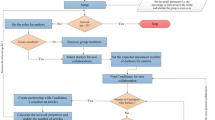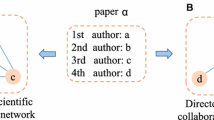Abstract
Scientific research collaboration networks are well-established research topics, which can be divided into two kinds of research paradigms: (1) The topological features of the whole scientific collaboration networks and the collaboration representations in some given fields. (2) The individual nodes’ characteristics in the collaboration networks and their endorsements in the networks. However, in the above studies, all the nodes’ roles in the scientific collaboration network are the same, all of whom are called collaborators, thus the relationships among all the nodes in the scientific collaboration network are symmetric, and the scientific collaboration network is undirected. Such symmetric roles and relationships in the undirected networks have no incentive effects on the members’ participations and efforts in the team’s scientific research. In this paper, the roles of team members in the scientific research collaborations are defined, including the scientific research pioneers and contributors, their collaboration relationships are considered from the viewpoint of principal-agent theory, and then the directed scientific collaboration network is built. Then the benefit distribution mechanism in the team members’ networked scientific research collaborations is presented, which will encourage the team members with different roles to make their efforts in their scientific research collaborations and improve the quality of scientific research outputs. An example is used to test the above ideas and conclude that the individual member’s real outputs not only lie in his/her real scientific research efforts, but also rest with his/her contributions to other members’ scientific research.


Similar content being viewed by others
References
Abbasi, A., Hossain, L., & Leydesdorff, L. (2012). Betweenness centrality as a driver of preferential attachment in the evolution of research collaboration networks. Journal of Informetrics, 6(3), 403–412.
Abbasi, A., Hossain, L., Uddin, L., & Rasmussen, K. (2011). Evolutionary dynamics of scientific collaboration networks: Multi-levels and cross-time analysis. Scientometrics, 89(2), 687–710.
Alonso, J. A., & Lamata, M. T. (2006). Consistency in the analytic hierarchy process: A new approach. International Journal of Uncertainty, Fuzziness and Knowledge-Based Systems, 14(4), 445–459.
Aminbakhsh, S., Gunduz, M., & Sonmez, R. (2013). Safety risk assessment using analytic hierarchy process (AHP) during planning and budgeting of construction projects. Journal of Safety Research, 46(9), 99–105.
Andrade, H. B., López, E. R., & Martín, T. B. (2009). Dimensions of scientific collaboration and its contribution to the academic research groups’ scientific quality. Research Evaluation, 18(4), 301–311.
Aziz, N. A., & Rozing, M. P. (2013). Profit(p)-index: The degree to which authors profit from co-authors. PLoS ONE, 8(4), 1–7.
Bordons, M., Aparicio, J., & Costas, R. (2013). Heterogeneity of collaboration and its relationship with research impact in a biomedical field. Scientometrics, 96(2), 443–466.
Dağdeviren, M., Yavuz, S., & Kılınç, N. (2009). Weapon selection using the AHP and TOPSIS methods under fuzzy environment. Expert Systems with Applications, 36(4), 8143–8151.
Dance, A. (2012). Who’s on first? Nature, 489, 591–593.
Deng Q. H., & Wang Z. P. (2011). Degree centrality in scientific collaboration supernetwork. In 2011 International Conference on Information Science and Technology (ICIST) (pp. 259–262), March 26–28.
Ding, Y. (2011). Scientific collaboration and endorsement: Network analysis of coauthorship and citation networks. Journal of Informetrics, 5(1), 187–203.
Ellis, D., & Haugan, M. (1997). Modeling the information seeking patterns of engineers and research scientists in an industrial environment. Journal of Documentation, 53(4), 384–403.
Ellis, D., Oldridge, R., & Vasconcelos, A. (2004). Community and virtual community. Annual Review of Information Science and Technology, 38(1), 145–186.
Fine, M. A., & Kurdek, L. A. (1993). Reflections on determining authorship credit and authorship order on faculty-student collaborations. American Psychologist, 48(11), 1141–1147.
Goldfinch, S., Dale, T., & DeRouen, K. (2003). Science from the periphery: Collaboration, networks and ‘periphery effects’ in the citation of New Zealand Crown Research Institute Articles 1995–000. Scientometrics, 57(3), 321–337.
Granovetter, M. (1985). Economic action and social structure: The problem of embeddedness. American Journal of Sociology, 91(3), 481–510.
Guraya, S. Y. (2013). Bandwagon of impact factor for journal scientometrics. Journal of Taibah University Medical Sciences, 8(2), 69–71.
Harkins, A. (2010). Team incentives in networks. Retrieved December 15, 2011, from http://www2.warwick.ac.uk/fac/soc/economics/pg/current/d_programme/upgrade_presentatins/team_incentives_in_networks.pdf.
He, W., & Wei, K. (2009). What drives continued knowledge sharing? An investigation of knowledge-contribution and -seeking beliefs. Decision Support System, 46(4), 826–838.
Henneman, S., Rybski, D., & Liefner, I. (2012). The myth of global science collaboration–collaboration patterns in epistemic communities. Journal of Informetrics, 6(2), 217–225.
Katz, J. S., & Martin, B. R. (1997). What is research collaboration? Research Policy, 26(1), 1–18.
Koustas, Z., & Serletis, A. (1999). On the Fisher effect. Journal of Monetary Economics, 44(1), 105–130.
Lake, D. (2009). Who’s on First? Listing authors by relative contribution trumps the alphabet. Political Science and Politics, 43(1), 43–47.
Lee, S., & Bozeman, B. (2005). The impact of research collaboration on scientific productivity. Social Studies of Science, 35(5), 673–702.
Leydesdorff, L., & Wagner, C. S. (2008). International collaboration in science and the formation of a core group. Journal of Informetrics, 2(4), 317–325.
Liang, L., & Zhu, L. (2002). Major factors affecting China’s inter-regional research collaboration: Regional scientific productivity and geographical proximity. Scientometrics, 55(2), 287–316.
Liu, C., Shan, W., & Yu, J. (2011). Shaping the interdisciplinary knowledge network of China: A network analysis based on citation data from 1981 to 2010. Scientometrics, 89(1), 89–106.
Liu, X. L., Wang, M. Y., Zhang, L., Wang, P., & Zhou, Z. X. (2013). Journal impact factor: Is it only used in China and South Asia? Current Science, 105(11), 1480–1484.
Matthew, O. J., & Alison, W. (2002). The evolution of social and economic networks. Journal of Economic Theory, 106(2), 265–295.
Meho, L. I., & Tibbo, H. R. (2003). Modeling the information-seeking behavior of social scientists: Ellis’s study revisited. Journal of the American Society of Information Science and Technology, 54(6), 570–587.
Newman, M. (2001). The structure of scientific collaboration networks. Proceedings of the National Academy of Sciences of the United States of America, 98(2), 404–409.
Newman, M. (2002). Assortative mixing in networks. Physical Review Letters, 89(20), 20870.
Newman, M. (2004). Coauthorship networks and patterns of scientific collaboration. Proceedings of the National Academy of Sciences of the USA (PNAS), 101(Suppl. 1), 5200–5205.
Osborne, J. W., & Holland, A. (2009). What is authorship, and what should it be? A survey of prominent guidelines for determining authorship in scientific publications. Practical Assessment, Research & Evaluation, 14(15), 1–19.
Persson, O., Glänzel, W., & Danell, R. (2004). Inflationary bibliometric values: The role of scientific collaboration and the need for relative indicators in evaluative studies. Scientometrics, 60(3), 421–432.
Portes, A. (2010). Economic sociology: A systematic inquiry. Princeton, NJ: Princeton University Press.
Riesenberg, D., & Lundberg, G. D. (1990). The order of authorship: Who’s on first? The Journal of the American Medical Association, 264(14), 1857.
Romer, P. M. (1986). Increasing returns and long-run growth. Journal of Political Economy, 94, 1002–1037.
Seglen, P. O. (1997). Why the impact factor of journals should not be used for evaluating research. British Medical Journal, 314(7079), 498–502.
Sonnenwald, D. H. (2007). Scientific collaboration: A synthesis of challenges and strategies. Annual Review of Information Science and Technology, 41(1), 643–681.
Tijssen, R. J. W., Waltman, L., & Eck, N. J. V. (2012). Research collaboration and the expanding science grid: Measuring globalisation processes worldwide. Retrieved December 7, 2012, from http://arxiv.org/abs/1203.4194.
Tscharntke, T., Hochberg, M., Rand, T., Resh, V., & Krauss, J. (2007). Author sequence and credit for contributions in multiauthored publications. PLoS Biology, 5(1), 13–14.
Wager, C. S. (2008). The new invisible college: Science for development. Washington, DC: Brookings Press.
Wasserman, S., & Faust, K. (1994). Social network analysis: Methods and applications (pp. 92–166). New York: Cambridge University Press.
Watts, A. (2011). A dynamic model of network formation. Games and Economic Behavior, 34(2), 331–341.
Yan, X. B., Zhai, L., & Fan, W. G. (2013). C-index: A weighted network node centrality measure for collaboration competence. Journal of Informetrics, 7(1), 223–239.
Zhang, C. T. (2009). A proposal for calculating weighted citations based on author rank. EMBO Reports, 10(5), 416–417.
Acknowledgments
Research for this paper is partly supported by the National Social Science Foundation Grant of China (No. 12CTQ029), the National Natural Science Foundation Grants of China (Nos. 71273076 and 71202159), and the Humanities and Social Science Project of the Educational Ministry in China under Grant No. 13YJC630166.
Author information
Authors and Affiliations
Corresponding author
Rights and permissions
About this article
Cite this article
Zhao, L., Zhang, Q. & Wang, L. Benefit distribution mechanism in the team members’ scientific research collaboration network. Scientometrics 100, 363–389 (2014). https://doi.org/10.1007/s11192-014-1322-7
Received:
Published:
Issue Date:
DOI: https://doi.org/10.1007/s11192-014-1322-7
Keywords
- Scientific research collaboration
- Benefit distribution mechanism
- Scientific research collaboration network
- Scientific research team




